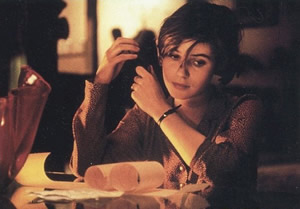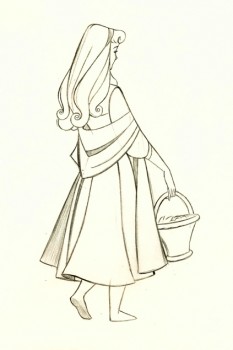Animation &Commentary 04 Apr 2006 06:58 am
Double Lives
 – I thought about Michael Barrier’s argument supporting the notion that it would be best for one person to be the sole animator of a character throughout a film. On his excellent site, this argument has played out for at least several months. It’s a good one.
– I thought about Michael Barrier’s argument supporting the notion that it would be best for one person to be the sole animator of a character throughout a film. On his excellent site, this argument has played out for at least several months. It’s a good one.
I thought about this when I read this week’s New Yorker Magazine review by Anthony Lane of the re-release of Kieslowski‘s The Double Life of Veronique. In that brilliant film, one actress plays two roles – they may be one character, East and West divided/together – but they’re played as if they were two. The characters are separated and move physically closer together throughout the film and even come close to passing each other.
In some ways this isn’t too far from the hackneyed TV cliché – the one actor plays both himself and his evil twin brother. However, in the Kieslowski film, it’s done very well and is germane to the film. Kieslowski isn’t the only one to do this. There were the evil/good twins played by Margot Kidder in Brian de Palma’s Sisters; there was Kim Novak’s dual/singular role in Hichcock’s Vertigo, and, of course, there were Hayley Mills and Lindsay Lohan in two separate versions of The Parent Trap.
 What made me think about Barrier’s argument, was my reading some of the scene breakdowns for Disney’s Sleeping Beauty. We all know that Marc Davis animated the evil queen, Maleficent. I was reminded, reading the breakdowns, that he also animated some of the virginal Aurora in the wooded scenes along with Hal Ambro.
What made me think about Barrier’s argument, was my reading some of the scene breakdowns for Disney’s Sleeping Beauty. We all know that Marc Davis animated the evil queen, Maleficent. I was reminded, reading the breakdowns, that he also animated some of the virginal Aurora in the wooded scenes along with Hal Ambro.
Given the Barrier premise, that one animator should animate or supervise the same character, we have to ask what about the animator who animates two or more characters in the same film. (In the world in which I’ve been animating, this is the more likely.)
Bill Tytla and Fred Moore supervised most of the seven dwarfs. Here we have an animator animating seven principal and titular characters. How does this play into the theory? Is it obvious in that the animator would just follow through on all of her(his) characters and try to give different personalities to them?
(Click image to enlarge.)
Does asking this question preclude that the animator can create seven personalities in the same film? (Moore and Tytla did pretty well by their characters, although it was probably easier to vary the animation of characters named Sleepy and Happy than it would be to give personalities to two named Bill and Mark. There’s always the Lindsay Lohan/Hayley Mills route – give one a British accent the other an American.)
I ask it only because I’m curious to know how one would gauge this side of the same argument. And I wonder if any out there have thoughts on this? Or experiences?

on 04 Apr 2006 at 3:13 pm 1.John Celestri said …
Michael,
I, myself, prefer to handle the animation of one character throughout a film, just to keep the personality development consistant. However, putting on my director’s hat, if I have to split the character’s screen time amongst several animators, I would cast them to their strengths and have them each concentrate on the aspects of the character’s personality they can handle the best.
The best parallel I can remember seeing in live action is in the Godfather Trilogy where Brando and DeNiro share the Vito Corleone role at different ages. Yes, I know that Brando could not possibly play the younger role and vice versa, but I don’t remember two actors doing a better job of sharing such a major role.
Just to stir things up a little, I think it’s easier for two mediocre animators to share a character than for two very strong animators to do so. I said “easier” not “impossible”.
on 05 Apr 2006 at 6:47 am 2.Michael said …
That’s an interesting argument, John, but I can’t help thinking that two mediocre animators would each give you half of a mediocre performance. They can be controlled more by the director, but their work isn’t going to have as much of a bite.
I think if two animators are strong, not stubborn, they’ll know enough to work together. Kimball and Moore doing Mickey in “Nifty Nineties” (among other collaborations) or Tytla and Moore doing the dwarfs are examples of two indomitable animators working together.
on 05 Apr 2006 at 7:21 pm 3.John Celestri said …
Maybe my experience has been tainted, but the few times I’ve been in the position of sharing a character with another strong animator, it turned into a tug-of-war match. I think the key ingredient for two strong animators working well together is that they respect each other and have enough security within themselves that they don’t fear the other’s talent. I suspect that was the case with the Kimball/Moore and Tytla/Moore collaborations.
on 06 Apr 2006 at 6:42 am 4.Michael said …
Undoubtedly, working close together is part of it. There has to be a lot of communication and fun in it. The current system of things often seems to knock out the fun part.
on 12 Apr 2006 at 6:29 pm 5.Stephen Worth said …
Marc Davis in Sleeping Beauty is the perfect example to show why it’s more important to cast animators by the requirements of the scene, than it is to mechanically cast them by character.
Maleficent wasn’t animated by Davis alone, even thought The Illusion of Life would give you that impression. Davis did the subtle acting scenes, and Ambi Paliwoda did the action scenes. Ambi is the one bawling out the goons and raising her staff on top of the tower (with some help from Marc on the faces). Paliwoda’s visceral outbursts of energy provided the perfect contrast to Davis’s smooth sophistication. It gave the character the depth and menace it wouldn’t have otherwise had.
Davis provided a similar function with Briar Rose. He provided the subtle acting in the sequence where the prince is holding her hand and she’s trying to get away (matched seamlessly with Kahl’s prince animation- look at this scene for a perfect example of two animtors working off each other…) Ambro handled the scenes where she’s walking through the woods- the more technical scenes where she’s part of the overall design of the frame, not acting. It would have been a waste to sit Davis down and have him do scene after scene of her walking through the forest. His time was better spent on, not just the characters that suited him, but the action.
See ya
Steve
on 13 Apr 2006 at 7:27 am 6.Michael said …
Ambro was often given dance scenes of a young female. I believe it became a specialty of his.
Davis definitely supervised Paliwoda, and there can be no denying that Maleficent was his girl.